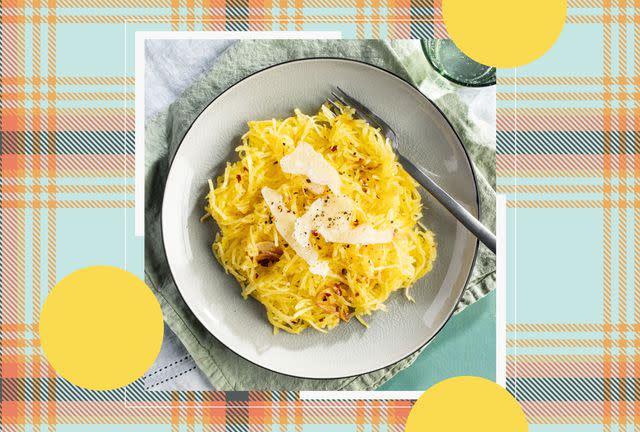My Favorite Anti-Inflammatory Side Dish Is Perfect for Fall
You'll want to pick up the key ingredient the next time you go grocery shopping.
Reviewed by Dietitian Emily Lachtrupp, M.S., RD
Spaghetti squash hasn't had an easy ride.
It's taken a while for the hardy vegetable with the funny name to enter the mainstream culinary world. In the 1960s and '70s, it was a health-food fad, a friend of hippies and homesteaders. In the '80s and '90s, it was the darling of the low-calorie, low-fat and low-cholesterol crowd, the ultimate "guilt-free" food. In more recent years, it's gained a following from followers of the keto diet and others looking for a gluten-free alternative to traditional pasta. No wonder a Chicago Tribune headline once lamented, "Pity the Misunderstood Spaghetti Squash"!
I was first introduced to spaghetti squash through my farm-box subscription. It was one of many new-to-me veggies from the weekly service that I was determined to put to good use, and Sautéed Spaghetti Squash with lemon, garlic, Parmesan cheese and black pepper seemed like a good place to start. Frankly, there are few things covered in Parmesan that I don't love, so my expectations were already high. Still, I was blown away by the squash tendrils' soft, smooth texture and nutty, buttery flavor. How could such a simple recipe be so delicious?

Before long, I was topping a bowl with a fried egg, and leftovers were finding their way into frittatas, salads and tacos. This veggie had it all. It was tasty, affordable and versatile. I didn't even mind the longish time it takes for the squash to roast in the oven. (Call me a purist, but the microwave doesn't cut it for me.) I was happy to give it a quick chop, remove the seeds, and rub in some olive oil, salt and pepper before letting it do its thing in my oven with minimal supervision as I puttered around the kitchen, prepping other ingredients and washing dishes. I love that spaghetti squash doesn't require diligent attention, and, unlike risotto or stir-fry, I can just set it and forget it.
Related: Your Foolproof Guide on How to Cook Spaghetti Squash Perfectly
While my first introduction to spaghetti squash delighted me, I was soon enamored for a more important reason. I recently learned that gluten is the primary culprit behind the inflammation that's plaguing me. Suddenly, having hearty ingredients to replace pasta, couscous and barley wasn't just a handy alternative to my usual meal plan. It was going to take center stage in my life. Spaghetti squash's health benefits, which I hadn't much considered as I slurped down the buttery, cheesy strands, were now very much on my radar.
Registered dietitian Jennifer Neale notes that spaghetti squash contains moderate amounts of vitamin C and carotenoids—both of which have anti-inflammatory benefits. Though spaghetti squash doesn't quite stack up against nutritional powerhouses like kale or berries, its versatility is nearly unmatched. Neale says: "Spaghetti squash is a great alternative to pasta for anyone with celiac disease or who struggles with digesting gluten, and it can be a great option for anyone who needs to manage their blood sugars, especially if you want to add other sources of carbohydrates to a meal (such as a delicious piece of garlic bread)."
One of the best things about spaghetti squash is its versatility. I've branched out from the base recipe I love and often top my spaghetti squash with curried lentils, veggie stew or mushrooms and sausage. While winter squashes like spaghetti squash are usually available year-round, they're primarily harvested in autumn in North America (and, with proper storage, can last into winter). And they tie in perfectly with the cozy comfort food many of us come to expect of the season.
Read the original article on Eating Well.

